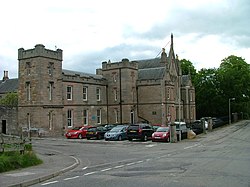| Dingwall Sheriff Court | |
|---|---|
 Dingwall Sheriff Court Dingwall Sheriff Court | |
| Location | Ferry Road, Dingwall |
| Coordinates | 57°35′41″N 4°25′13″W / 57.5946°N 4.4202°W / 57.5946; -4.4202 |
| Built | 1845 |
| Architect | Thomas Brown II |
| Architectural style(s) | Gothic Revival style |
| Listed Building – Category B | |
| Official name | Dingwall Sheriff Court including former police station, prison, gatepiers and railings, Ferry Road, Dingwall |
| Designated | 31 August 1983 |
| Reference no. | LB24500 |
 | |
Dingwall Sheriff Court is a former judicial structure in the High Street, Dingwall, Highland, Scotland. The complex, which was used as the headquarters of Ross and Cromarty County Council as well as the local courthouse before being converted for residential use in 2015, is a Category B listed building.
History

The Ross and Cromarty Commissioners of Supply served as the main administrative body for the county from 1667 until 1890 when the county council was created and took over most of the commissioners' functions. In the early 19th century, the commissioners met at 63–64 High Street but, in the early 1840s, they decided that a bespoke courthouse should be commissioned. The site they chose had been formed by filling in an artificial pit with hard rubble.
The new building was designed by Thomas Brown II in the Gothic Revival style, built in ashlar stone and was completed in 1845. The design involved an asymmetrical main frontage of nine bays facing onto Ferry Road. The central section of three bays, which was projected forward, featured an arched doorway with a hood mould flanked by lancet windows on the ground floor, a prominent tripartite window on the first floor and another lancet window in the gable above. The outer bays of the central section were fenestrated by oriel windows on both floors and there were gables above. The left-hand section of five bays featured castellated towers at either end, while the right-hand section of just one bay also took the form of a castellated tower. A prison block was erected to the rear of the courthouse. Internally, the principal room was the main courtroom on the first floor.
A three-bay police station, designed by Andrew Maitland, was erected to the right of the courthouse in 1865. Following the implementation of the Local Government (Scotland) Act 1889, which established county councils in every county, Ross and Cromarty County Council established its offices in the building. The building was the venue for the inquiry into the deaths of the eight people who died as a result of the Loch Maree Hotel botulism poisoning in 1922.
The county council relocated to the Old Academy Buildings in Tulloch Street in the 1930s and the police service vacated the complex when they moved to a modern police station to the west of County Buildings in 1972. The Ferry Road building continued to accommodate the sheriff court until its closure in January 2015, and was subsequently converted for residential use.
See also
References
- ^ Historic Environment Scotland. "Dingwall Sheriff Court including former police station, prison, gatepiers and railings, Ferry Road, Dingwall (LB24500)". Retrieved 20 December 2022.
- "Dingwall Sheriff Court". Ross and Cromarty Heritage Society. Retrieved 20 December 2022.
- "Dingwall Conservation Area: Conservation Area Character Appraisal" (PDF). The Highland Council. 1 July 2010. p. 31. Retrieved 18 December 2022.
- Shennan, Hay (1892). Boundaries of Counties and Parishes in Scotland: as settled by the Boundary Commissioners under the Local Government (Scotland) Act, 1889. Edinburgh: William Green & Sons – via Internet Archive.
- McThenia, Tal (15 November 2018). "The Lethal Lunch That Shook Scotland". Atlas Obscura. Retrieved 19 November 2018.
- Planning and Construction. Vol. 5. Todd Reference Books. 1948. p. 459.
County Architect's Department, Old Academy, Tulloch Street, Dingwall, Ross-shire
- "Police Station". Dictionary of Scottish Architects. Retrieved 18 December 2022.
- "Speeches to be made before controversial closure of Dingwall Court". Press and Journal. 30 January 2015. Retrieved 20 December 2022.
- Woodham, A. A. "Dingwall: A short History". Ross and Cromarty Heritage Society. Retrieved 18 December 2022.
- "Closed Highland courthouse could start new life as family home". Press and Journal. 1 September 2016. Retrieved 20 December 2022.
- "Couple move into their home… Which just happens to be a former Highland courthouse". Press and Journal. 7 November 2016. Retrieved 20 December 2022.
- Robson, Peter; Rodger, Johnny (2017). The Spaces of Justice The Architecture of the Scottish Court. Fairleigh Dickinson University Press. p. 72. ISBN 978-1683930891.
External links
 Media related to Dingwall Sheriff Court at Wikimedia Commons
Media related to Dingwall Sheriff Court at Wikimedia Commons